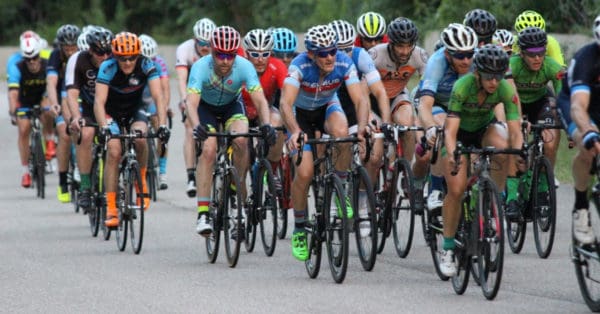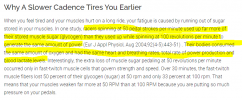Philskies
Level 3 Valued Member
Everywhere I go on the internet, I see questions about heart rate training. Questions like: What heart rate should I be at to stay aerobic? How do I calculate MAF for my particular activity? I, too, was very confused for a VERY long time because almost everyone is looking at the aerobic/glycolitic systems through the lens of heart rate and overall systemic metabolism, rather than local musclular metabolism. So what do I mean by this? I want to share some training examples to hopefully clarify what was once so confusing to me.
Suppose you were to do the following unlikely exercise: lifting a 1lb dumbbell (requiring only type 1 fibers) with your left arm while simultaneously lifting a 30lb dumbbell (requiring type 2 fibers) with your right arm. Let's say after a minute of this, your heart rate is 100 and your right arm is starting to give out. Are you training aerobically or glycolitically? The old me would have said aerobically because my heart rate is so low, but if we look at this through the lens of the muscle, we can tell that it has NOTHING to do with the heart rate, and everything to do with the local muscle. Answer: left arm is working aerobically, and right arm is working glycolitically.
Suppose you were to do the above dumbbell exercise while on stationary bike pedaling at a speed you can do all day. Now the legs muscles and left arm are working aerobically. If we increase the resistance on the bike such that you start feeling the legs burn in a few minutes, now your legs and right arm are working glycolitically, while the left arm is still aerobic.
Let's look at a rowing example which is much more realistic. Suppose you were to row at a fairly easy intensity at a medium cadence and your heart rate is 120. If you can do this all day, most likely all your muscles will be working aerobically. Let's say you were to start pulling much harder (requiring type 2 fibers) but at a much lower cadence such that your heart rate STAYS at 120. Because of the nature of rowing, your arms and back muscles start burning first after 5 minutes but your legs still feel like they can go all day. Are you aerobic or glycolitic? If we just look at heart rate using MAF, we think we're still aerobic. In actuality, your arms/back have gone glycolitic while your legs are still aerobic. In this example, we can now see what a silly statement "I'm rowing at my MAF heart rate to train aerobically" is!!!
We can also see how silly is it to try to use MAF across differing sports when it may not even work within the SAME sport like in the example above? Don't get me wrong, I'm not trying to bash MAF. It's definitely an easy starting point for beginners and mostly just for running, but I don't see it very applicable in other ways.
Consider power zones in cycling: By changing the cadence, we can change the energy system used by the legs without changing the power. There may be some other factors here like using different muscles at different cadences, or inertia perhaps. I've often seen the recommendation to increase cadence if the legs start to burn before the lungs give out.
After some more thought, this seems to apply to running also. If we maintain the same speed but the lower the cadence and increase the stride, more of the faster twitch muscles are used, whereas if we increase cadence and reduce the stride, the slower twitch muscles are used. In other words, during say an easy run, we can choose which fibers on the spectrum of slowest>slower>slow> by manipulating the cadence/stride without changing the speed. So maybe I should start varying the above to maximize training on the FULL specrum of slow fibers? I do have a habit of running the same routes at the same speed/cadence/stride on my easy runs.
Anyways, this is only my second post. I'm interested in hearing what ya'll think of my random shower thoughts! This forum rocks; I've learned so much here, so thanks!!
Suppose you were to do the following unlikely exercise: lifting a 1lb dumbbell (requiring only type 1 fibers) with your left arm while simultaneously lifting a 30lb dumbbell (requiring type 2 fibers) with your right arm. Let's say after a minute of this, your heart rate is 100 and your right arm is starting to give out. Are you training aerobically or glycolitically? The old me would have said aerobically because my heart rate is so low, but if we look at this through the lens of the muscle, we can tell that it has NOTHING to do with the heart rate, and everything to do with the local muscle. Answer: left arm is working aerobically, and right arm is working glycolitically.
Suppose you were to do the above dumbbell exercise while on stationary bike pedaling at a speed you can do all day. Now the legs muscles and left arm are working aerobically. If we increase the resistance on the bike such that you start feeling the legs burn in a few minutes, now your legs and right arm are working glycolitically, while the left arm is still aerobic.
Let's look at a rowing example which is much more realistic. Suppose you were to row at a fairly easy intensity at a medium cadence and your heart rate is 120. If you can do this all day, most likely all your muscles will be working aerobically. Let's say you were to start pulling much harder (requiring type 2 fibers) but at a much lower cadence such that your heart rate STAYS at 120. Because of the nature of rowing, your arms and back muscles start burning first after 5 minutes but your legs still feel like they can go all day. Are you aerobic or glycolitic? If we just look at heart rate using MAF, we think we're still aerobic. In actuality, your arms/back have gone glycolitic while your legs are still aerobic. In this example, we can now see what a silly statement "I'm rowing at my MAF heart rate to train aerobically" is!!!
We can also see how silly is it to try to use MAF across differing sports when it may not even work within the SAME sport like in the example above? Don't get me wrong, I'm not trying to bash MAF. It's definitely an easy starting point for beginners and mostly just for running, but I don't see it very applicable in other ways.
Consider power zones in cycling: By changing the cadence, we can change the energy system used by the legs without changing the power. There may be some other factors here like using different muscles at different cadences, or inertia perhaps. I've often seen the recommendation to increase cadence if the legs start to burn before the lungs give out.
After some more thought, this seems to apply to running also. If we maintain the same speed but the lower the cadence and increase the stride, more of the faster twitch muscles are used, whereas if we increase cadence and reduce the stride, the slower twitch muscles are used. In other words, during say an easy run, we can choose which fibers on the spectrum of slowest>slower>slow> by manipulating the cadence/stride without changing the speed. So maybe I should start varying the above to maximize training on the FULL specrum of slow fibers? I do have a habit of running the same routes at the same speed/cadence/stride on my easy runs.
Anyways, this is only my second post. I'm interested in hearing what ya'll think of my random shower thoughts! This forum rocks; I've learned so much here, so thanks!!



